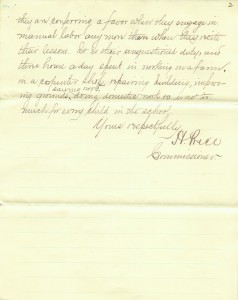Examine each primary source below and answer the questions underneath.
Click on the title to go to the original site.
Excerpt from The American Missionary, Volume 32, Issue 6, June 1878
THE INDIAN BOYS AT HAMPTON.
Visitors to St. Augustine, Fla., during the last three years have been directed to Capt.Pratts Indians as among the objects of interest in Fort Marion. There they were carried, as prisoners of war, in the spring of 1875, after the terrible massacres which had taken place in the Indian Territory by the Five Tribes. They went South, each with his legs fastened to a log with chains. They were filled with hatred over their real or fancied wrongs. One jumped from the cars, and was shot by the guard; one killed himself on the way. They wore only their Indian blankets, and had great brass hoops in their ears. They knew no word of English. It was their good fortune to fall into the hands of a Christian army officer, who, by his skill in management, and patience in seeking to do them good, at length won their confidence, and succeeded, with the help of a few benevolent ladies, in teaching them some of the simplest elements of civilization and learning. A few of them can read very well.
At the end of their second year, Mrs. Dr. Caruthers, of Tarrytown, N. Y., who had been teaching among them, determined to secure, if possible, the education of two young men of her class. She obtained permission from the Indian Commission, and raised money for the purpose. Other means and offers of help came in. At length it was found that twenty-two of them desired to go to school. They are now discharged from their imprisonment. The old chiefs go back to their people, greatly changed for the better. Fifteen of the young men were left at Hampton, April 13th, to be educated in the Normal Institute. They have begun their regular studies, and have been detailed to various departments of work, in shop and on farm. They seem perfectly happy and contented, and their new comrades treat them with kindness and consideration. Here is another of those curious comminglings, and crossings of lines, of which life is so full, and yet which never cease to surprise us. The African and the Indian meet at Hampton, to be trained together, to be intelligent citizens and Christians, and the teachers of their people. Thus the two races are brought face to face the two races whose past involves Americas greatest responsibilities; whose future, some of her hardest problems.
It costs $115 to keep one of these Indian boys at Hampton for a year that, with what he is able to earn by his labor. This amount has been pledged by individuals alone, or together, for the education of most of the number. Mrs. Caruthers, having done so much, has asked the A. M. A., through its President and its Secretary, to as-sume the tuition of one of her wards, and the Executive Committee desire to do so and Zone-ke-nh, twenty-one years of age, of the Kiowa tribe, will go to Hampton, in addition to those already there, as the pupil of the Association, if some of our friends, who may be especially interested in the elevation of the Indians, will make up this small amount, and help on this work, in which the elements are combined of romance, beneficence, and personality.
Questions:
1. What was this account printed in? Who would be reading this journal?
2. How did the author portray the Native American men after they received their education?
3. Do you think the author’s account is correct, why or why not?
4. What is the author asking people to do at the end of this account?
5. How does this account provide a different perspective of Native American treatment?
Map showing Indian reservations with the limits of the United States, 1883
Questions:
1. What color on the map represents Native American Reservations?
2. In what year was this map made?
3. Zoom in and look closely at the reservations. What trend do you see? (Does each reservation have only one Native American nation on it or several?)
4. How do you think the Native Americans felt about being on a reservation with different nations than their own?
5. How would this impact how Native Americans saw the U.S. government and their actions?
Read both pages below and then answer the questions.
Letter from the Commissioner of Indian Affairs to the Indian Agent at Quinault Reservation
Questions:
1. What issue is being addressed in this letter?
2. What is the Commissioner telling the Indian agent?
3. How do you think the Native Americans would react to this news?
4. Give one explanation of why this is just and one explanation of why this is unjust.



